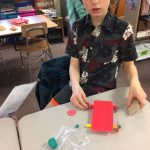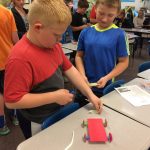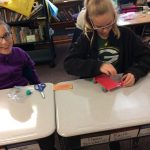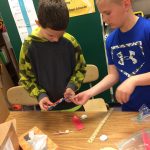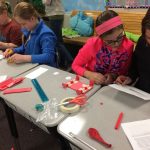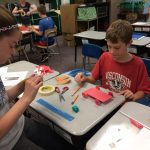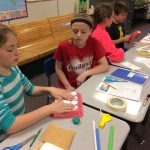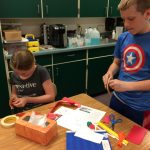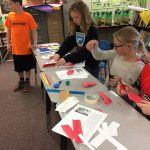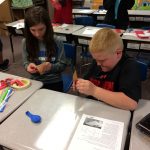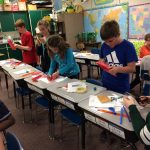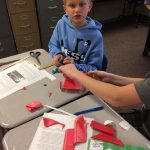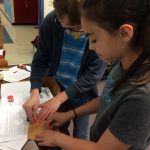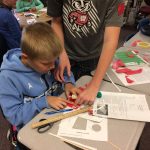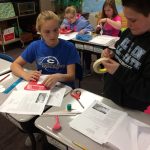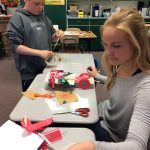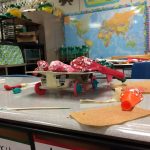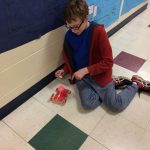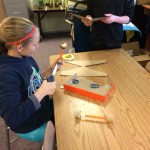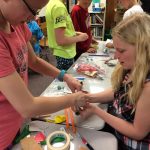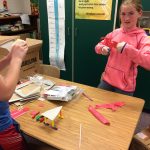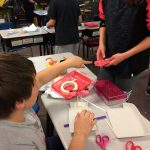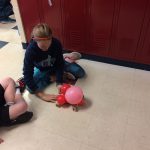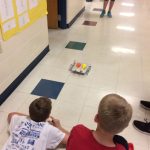Sir Isaac Newton. That’s where this project began. Sir Isaac Newton and his three Laws of Motion.
Law Number One: An object at rest tends to stay at rest. An object in motion tends to stay in motion. These conditions cannot change without being acted on by a force.
Law Number Two: Force equals mass times acceleration. The more force, the more acceleration.
Law Number Three: For every action there is an equal and opposite reaction.
We talked about these laws and were helped with our understanding of them by watching this Youtube video:
The students, in groups of two, were about to build cars. The body and wheels were cut from a styrofoam meat tray. The axle, to which the wheels were held steady with clay, was a wooden stir stick. The axle was positioned in a straw which was taped to the bottom of the car body. The car was powered by a balloon. All of the materials came as part of a kit that I purchased from Carolina Biological . What I liked about having this as a kit is that everyone had the exact same materials and the exact same set of directions. Each pair of students had to read and follow around 30 directions in order to complete their car.
The engagement and cooperation within the groups was impressive. I had them read through the directions with their partner before coming to get the materials. I wanted them to have an idea of where this was going, and what the materials were for. Once they had the materials, they read aloud the directions carefully and began assembling their car.
On the second day of class, students were fine tuning. Once the car was ready for testing, the students went into the hall outside our room to make sure the wheels were steady and the car moved straight. There were quite a few cars that veered to one side or another. In that case the students took the car back in to make adjustments to the wheels. When the cars were “competition ready”, we went down to the cafeteria to race them. Here is video of that for each of my three classes.
Two of the cars from the third class went extraordinary distances. The winner went 331 inches (27 1/2 feet)! The second highest distance was 318 inches (26 1/2 feet). No other car all day went even half that distance! At this point there was so much to talk about!
Why did some of the cars not move at all?
Why did the wheels keep falling off?
How were the winning cars different from the others?
The first thing we did back in the classroom was interview the builders of the two winning cars. The four students involved gave a lot of credit to the wheels of their cars. They spent time making sure they were uniformly round. They sanded them to help the car roll smoothly. And they measured to make sure the axle was as close to the center of the wheel as possible. Then they used the clay to make them snug on the axle. No wobbling!
Next we were ready to review Newton’s Laws of Motion.
We considered the second law: Force equals Mass times Acceleration. The balloon was the force that powered the car. Could we alter that? Would it help? Would more balloons result in more force? Will several balloons of different sizes lose all their air at the same rate? What would happen if the mass was increased? How would that impact the speed or distance? What if it was decreased? What could we make the body and wheels from besides styrofoam?
We considered the first law: An object in motion tends to stay in motion and an object at rest tends to stay at rest unless acted upon by a force. What force caused the cars to slow down and stop? Was it just the lack of air in the balloon? What about friction? What would happen if we altered the wheels? What else could we make them out of? What if we varied their width? How important is it to cut them so they are perfectly round? How important is it to measure to find the exact center of the wheel when attaching it to the axle?
We considered the third law: For every action there is an equal and opposite reaction. The air from the balloon is being released in one direction, but the car is moving in the opposite direction. Does the position of the balloon matter? Does the angle of the balloon and straw matter? Does the order of the different sized balloons matter?
Equipped with the experience of having already built one car along with the understanding gained from discussing the Laws of Motion, the same groups were asked to build another car. This time they could use whatever they wanted. The only thing I discouraged was bringing manufactured wheels off of a toy car. I put out cardboard, more balloons of different sizes, cardboard tubes and the remaining supplies that came with the initial kit. The students got started, knowing that they would have the opportunity to bring additional supplies from home.
On day four of this activity, the students had some time to get their cars “competition ready”. We had a car show (it seemed necessary now that no two cars looked alike). It was so interesting to see the variations. During work time, those who sought to use five balloons realized that it was difficult to keep the air in three while trying to blow up the others. In the end, three balloons was the most that anyone used. Here are the cars and then races from the three classes:
Even when the cars didn’t leave the starting line, the students laughed and enjoyed this challenge! In the end, the group whose first car went the furthest, built a second car that also went the furthest! Their second car was quite different from their first car in that the wheels in the second car were Kerr jar lids! They struggled during work time in keeping them from wobbling, but by the time the race was run, they had figured that out!
Another group used plastic bottle caps with holes drilled for the axle. The wheels worked beautifully, but this group struggled with attaching their balloon. Two other interesting sets of wheels were made out of cardboard tubes. One group used rubber bands around the tubes to grip the floor! These two groups struggled with attaching the wheels securely to an axle.
At the beginning of class the next day, I asked the students to share what they had learned while doing this project:
- The cardboard wheels went faster than the styrofoam wheels.
- The wheels on each axle needed to be the same size.
- The wheels needed to be sanded smooth.
- It really helped having a partner to talk with and to help hold parts while taping.
- Having more balloons didn’t always work. It was difficult to inflate and release several balloons all at once. Sometimes the first balloon was leaking air as the second was being filled.
- It gets too crowded to have too many balloons.
- The car body needs to be big enough to keep the balloons off the floor.
- Large balloons worked better than small ones.
- Masking tape worked well to tape the wheels to the axle.
When you watch the races of both car 1 and car 2, it is pretty obvious that overall there was more success with car 1. But in the end that didn’t matter. It wasn’t the end product that was the most important thing here. It was the mission and the process. It was the student input, the focus and the cooperation. Everyone had moments of frustration, but they worked through those moments. Students cheered each other on and made this a memorable fun activity. When asked if I should repeat this activity next year, ALL students said, “YES!”



